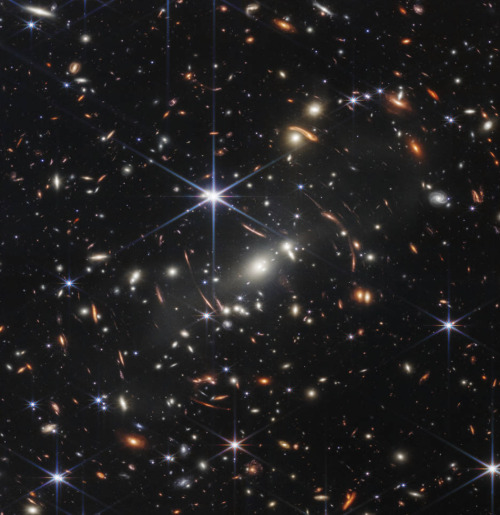This First Image From NASA’s James Webb Space Telescope Is The Deepest And Sharpest Infrared Image

This first image from NASA’s James Webb Space Telescope is the deepest and sharpest infrared image of the distant universe to date. Known as Webb’s First Deep Field, this image of galaxy cluster SMACS 0723 is overflowing with detail. Thousands of galaxies – including the faintest objects ever observed in the infrared – have appeared in Webb’s view for the first time. This slice of the vast universe covers a patch of sky approximately the size of a grain of sand held at arm’s length by someone on the ground.
More Posts from Primordialbitch and Others
Red paint on 1,000-year-old gold mask from Peru contains human blood proteins

Thirty years ago, archeologists excavated the tomb of an elite 40-50-year-old man from the Sicán culture of Peru, a society that predated the Incas. The man’s seated, upside-down skeleton was painted bright red, as was the gold mask covering his detached skull. Now, researchers reporting in ACS’ Journal of Proteome Research have analyzed the paint, finding that, in addition to a red pigment, it contains human blood and bird egg proteins.
The Sicán was a prominent culture that existed from the ninth to 14th centuries along the northern coast of modern Peru. During the Middle Sicán Period (about 900–1,100 A.D.), metallurgists produced a dazzling array of gold objects, many of which were buried in tombs of the elite class. In the early 1990s, a team of archaeologists and conservators led by Izumi Shimada excavated a tomb where an elite man’s seated skeleton was painted red and placed upside down at the center of the chamber. Read more.
did humans invent math or did we discover it
does math even exist
Unveiling the Center of Our Milky Way Galaxy

We captured an extremely crisp infrared image of the center of our Milky Way galaxy. Spanning more than 600 light-years, this panorama reveals details within the dense swirls of gas and dust in high resolution, opening the door to future research into how massive stars are forming and what’s feeding the supermassive black hole at our galaxy’s core.

Among the features coming into focus are the jutting curves of the Arches Cluster containing the densest concentration of stars in our galaxy, as well as the Quintuplet Cluster with stars a million times brighter than our Sun. Our galaxy’s black hole takes shape with a glimpse of the fiery-looking ring of gas surrounding it.
The new view was made by the world’s largest airborne telescope, the Stratospheric Observatory for Infrared Astronomy, or SOFIA.
Make sure to follow us on Tumblr for your regular dose of space: http://nasa.tumblr.com.
Ancient Bronze Age city reemerges from Iraq river after extreme drought

When an extreme drought caused a 3,400-year-old city to reemerge from a reservoir on the Tigris River in northern Iraq, archaeologists raced to excavate it before the water returned.
The Bronze Age city, at an archaeological site called Kemune, is a relic of the Mittani Empire (also spelled Mitanni Empire), an ancient kingdom that ruled parts of northern Mesopotamia from around 1500 B.C. to 1350 B.C. Researchers have long known of the remains of the city, but they can only investigate them during droughts.
Archaeologists partly excavated Kemune in 2018 and discovered a lost palace with 22-foot-high (7 meters) walls and chambers decorated in painted murals, Live Science previously reported. This time, researchers mapped most of the city, including an industrial complex and a multistory storage facility that likely held goods from all over the region, according to a statement released by the University of Tübingen in Germany. Read more.
TRAILER: “TIME MASTERS (LES MAÎTRES DU TEMPS)” (1982)
This animated science fiction feature film was directed by René Laloux and Tibor Hernádi but most notably - designed by the artist Mœbius. It is based on Stefan Wul’s 1958 science fiction novel L'Orphelin de Perdide (The Orphan of Perdide).
It’s about a boy, Piel, who is stranded on the desert planet Perdide, where giant killer hornets live. He awaits rescue by the space pilot Jaffar, the exiled prince Matton, his sister Belle and Jaffar’s old friend Silbad - who are all trying to reach Perdide and save Piel before it is too late.
If you’ve seen this film, you’ve probably seen the English language dubs by the BBC in 1987 or 1991 called Time Masters.
This is a super rare film that you can find on DVD, but usually used, and pretty expensive.
Gamma-ray Bursts: Black Hole Birth Announcements
Gamma-ray bursts are the brightest, most violent explosions in the universe, but they can be surprisingly tricky to detect. Our eyes can’t see them because they are tuned to just a limited portion of the types of light that exist, but thanks to technology, we can even see the highest-energy form of light in the cosmos — gamma rays.
So how did we discover gamma-ray bursts?
Accidentally!

We didn’t actually develop gamma-ray detectors to peer at the universe — we were keeping an eye on our neighbors! During the Cold War, the United States and the former Soviet Union both signed the Nuclear Test Ban Treaty of 1963 that stated neither nation would test nuclear weapons in space. Just one week later, the US launched the first Vela satellite to ensure the treaty wasn’t being violated. What they saw instead were gamma-ray events happening out in the cosmos!

Things Going Bump in the Cosmos
Each of these gamma-ray events, dubbed “gamma-ray bursts” or GRBs, lasted such a short time that information was very difficult to gather. For decades their origins, locations and causes remained a cosmic mystery, but in recent years we’ve been able to figure out a lot about GRBs. They come in two flavors: short-duration (less than two seconds) and long-duration (two seconds or more). Short and long bursts seem to be caused by different cosmic events, but the end result is thought to be the birth of a black hole.

Short GRBs are created by binary neutron star mergers. Neutron stars are the superdense leftover cores of really massive stars that have gone supernova. When two of them crash together (long after they’ve gone supernova) the collision releases a spectacular amount of energy before producing a black hole. Astronomers suspect something similar may occur in a merger between a neutron star and an already-existing black hole.

Long GRBs account for most of the bursts we see and can be created when an extremely massive star goes supernova and launches jets of material at nearly the speed of light (though not every supernova will produce a GRB). They can last just a few seconds or several minutes, though some extremely long GRBs have been known to last for hours!

A Gamma-Ray Burst a Day Sends Waves of Light Our Way!
Our Fermi Gamma-ray Space Telescope detects a GRB nearly every day, but there are actually many more happening — we just can’t see them! In a GRB, the gamma rays are shot out in a narrow beam. We have to be lined up just right in order to detect them, because not all bursts are beamed toward us — when we see one it’s because we’re looking right down the barrel of the gamma-ray gun. Scientists estimate that there are at least 50 times more GRBs happening each day than we detect!

So what’s left after a GRB — just a solitary black hole? Since GRBs usually last only a matter of seconds, it’s very difficult to study them in-depth. Fortunately, each one leaves an afterglow that can last for hours or even years in extreme cases. Afterglows are created when the GRB jets run into material surrounding the star. Because that material slows the jets down, we see lower-energy light, like X-rays and radio waves, that can take a while to fade. Afterglows are so important in helping us understand more about GRBs that our Neil Gehrels Swift Observatory was specifically designed to study them!

Last fall, we had the opportunity to learn even more from a gamma-ray burst than usual! From 130 million light-years away, Fermi witnessed a pair of neutron stars collide, creating a spectacular short GRB. What made this burst extra special was the fact that ground-based gravitational wave detectors LIGO and Virgo caught the same event, linking light and gravitational waves to the same source for the first time ever!

For over 10 years now, Fermi has been exploring the gamma-ray universe. Thanks to Fermi, scientists are learning more about the fundamental physics of the cosmos, from dark matter to the nature of space-time and beyond. Discover more about how we’ll be celebrating Fermi’s achievements all year!
Make sure to follow us on Tumblr for your regular dose of space: http://nasa.tumblr.com
New type of star system? Mysterious radio signal puzzles astronomers
by Laura Nicole Driessen

Meerkat telescope. Sotiris Sanidas, Author provided
After observing a part of the sky near the Southern Constellation of Ara for about two months using MeerKAT, a radio telescope based in the Karoo desert in South Africa, our team of scientists noticed something strange. The radio emission of an object brightened by a factor of three over roughly three weeks.
Intrigued, we continued watching the object and followed this up with observations from other telescopes. We discovered that the unusual flare came from a binary star system – two stars orbiting each other – in our own galaxy. The finding, published in the Monthly Notices of the Royal Astronomical Society, has, however, turned out to be very difficult to explain.
Keep reading
Hubble fortuitously discovers a new galaxy in the cosmic neighborhood
Astronomers using the NASA/ESA Hubble Space Telescope to study some of the oldest and faintest stars in the globular cluster NGC 6752 have made an unexpected finding. They discovered a dwarf galaxy in our cosmic backyard, only 30 million light-years away. The finding is reported in the journal Monthly Notices of the Royal Astronomical Society: Letters.

An international team of astronomers recently used the NASA/ESA Hubble Space Telescope to study white dwarf stars within the globular cluster NGC 6752. The aim of their observations was to use these stars to measure the age of the globular cluster, but in the process they made an unexpected discovery.
Keep reading



A Russian zoo is home to a unique animal - the liger. It is half-lioness, half-tiger. Mother Zita is pictured licking her one month old liliger cub
-
 freeyourselfopenyourmind liked this · 1 month ago
freeyourselfopenyourmind liked this · 1 month ago -
 vhincent liked this · 2 months ago
vhincent liked this · 2 months ago -
 moonage-daydreamy reblogged this · 2 months ago
moonage-daydreamy reblogged this · 2 months ago -
 sixsixmax reblogged this · 2 months ago
sixsixmax reblogged this · 2 months ago -
 highemperorcuco reblogged this · 3 months ago
highemperorcuco reblogged this · 3 months ago -
 highemperorcuco liked this · 3 months ago
highemperorcuco liked this · 3 months ago -
 heraio reblogged this · 3 months ago
heraio reblogged this · 3 months ago -
 myboardforastetyks reblogged this · 3 months ago
myboardforastetyks reblogged this · 3 months ago -
 chojrak-making-things reblogged this · 4 months ago
chojrak-making-things reblogged this · 4 months ago -
 chojrak-making-things liked this · 4 months ago
chojrak-making-things liked this · 4 months ago -
 no32557038 liked this · 5 months ago
no32557038 liked this · 5 months ago -
 leolant liked this · 5 months ago
leolant liked this · 5 months ago -
 paleblueiris reblogged this · 5 months ago
paleblueiris reblogged this · 5 months ago -
 smol-nerd-girl liked this · 5 months ago
smol-nerd-girl liked this · 5 months ago -
 sleepystellarsister reblogged this · 6 months ago
sleepystellarsister reblogged this · 6 months ago -
 anna1wh3q liked this · 6 months ago
anna1wh3q liked this · 6 months ago -
 ant-ikoi liked this · 6 months ago
ant-ikoi liked this · 6 months ago -
 starflit reblogged this · 6 months ago
starflit reblogged this · 6 months ago -
 thief-and-dragonfly reblogged this · 8 months ago
thief-and-dragonfly reblogged this · 8 months ago -
 tofu-goblin liked this · 8 months ago
tofu-goblin liked this · 8 months ago -
 shetillstheearth reblogged this · 11 months ago
shetillstheearth reblogged this · 11 months ago -
 uneevee liked this · 1 year ago
uneevee liked this · 1 year ago -
 meltedgallium reblogged this · 1 year ago
meltedgallium reblogged this · 1 year ago -
 meltedgallium liked this · 1 year ago
meltedgallium liked this · 1 year ago -
 band-geek-727 liked this · 1 year ago
band-geek-727 liked this · 1 year ago -
 lukadjo reblogged this · 1 year ago
lukadjo reblogged this · 1 year ago -
 lukadjo liked this · 1 year ago
lukadjo liked this · 1 year ago -
 takofukkatsumi liked this · 1 year ago
takofukkatsumi liked this · 1 year ago -
 straightjacketenthusiast liked this · 1 year ago
straightjacketenthusiast liked this · 1 year ago -
 kostasnj-blog liked this · 1 year ago
kostasnj-blog liked this · 1 year ago -
 happyheidi liked this · 1 year ago
happyheidi liked this · 1 year ago -
 stbrother reblogged this · 1 year ago
stbrother reblogged this · 1 year ago -
 theredshoes reblogged this · 1 year ago
theredshoes reblogged this · 1 year ago -
 theredshoes liked this · 1 year ago
theredshoes liked this · 1 year ago -
 stymul liked this · 1 year ago
stymul liked this · 1 year ago -
 r-dovedale liked this · 1 year ago
r-dovedale liked this · 1 year ago -
 artandotherprettystuff reblogged this · 1 year ago
artandotherprettystuff reblogged this · 1 year ago -
 arcticfritillary reblogged this · 1 year ago
arcticfritillary reblogged this · 1 year ago -
 odessa-castle reblogged this · 1 year ago
odessa-castle reblogged this · 1 year ago

